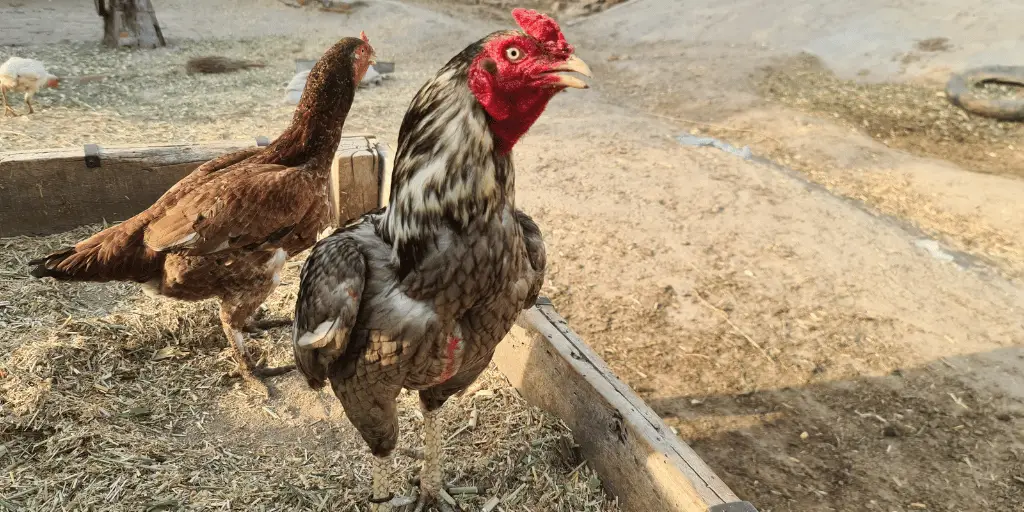Shamo chickens originated in Japan, dating back to the 17th century. Initially bred for cockfighting, these birds were highly valued for their strength, endurance, and fighting prowess.
As cockfighting became less popular, Shamo chickens were bred for their unique appearance and qualities, eventually resulting in the various types of Shamo chickens we see today.
“Shamo” itself translates to “fighting chicken,” reflecting their original purpose. Shamo chickens, also known as O-Shamo or Choshu Shamo, are a breed of giant, aggressive chickens with a long and storied history in Japan.
This comprehensive guide will explore the world of Shamo chickens, their characteristics, lifespan, temperament, care requirements, and more.
Whether you’re considering adding these birds to your flock or simply curious about their fascinating background, this guide is for you.
History and Origin of Shamo Chickens
The exact origin of Shamo chickens are still being determined, as their history dates back several centuries, and many legends and myths surround their origins.
One theory suggests that Shamo chickens were brought to Japan from Siam (now Thailand) during the Ayutthaya Kingdom (1350-1767).
It is believed that Japanese feudal lords, known as daimyo, imported these birds for their strength and fighting abilities. The name “Shamo” itself is said to be derived from “Siam” or “Shan,” which was the name given to birds imported from Southeast Asia.
Another theory suggests that Shamo chickens have Chinese origins. According to this theory, the birds were imported from China during the Tang Dynasty (618-907) and brought to Japan via the Korean Peninsula.
Other chickens with similar characteristics and fighting abilities, such as the Malay breed, may have influenced the development of the Shamo breed.
Regardless of their exact origin, Shamo chickens were initially used for cockfighting, a popular pastime among the samurai class in feudal Japan. The samurai valued these birds for their aggressive nature, size, and fighting prowess.
Over time, selective breeding programs were implemented to enhance these qualities, resulting in development the distinct Shamo breed we know today.
Notably, cockfighting is illegal or restricted in many countries, including Japan. Therefore, the focus on Shamo chickens has shifted towards their aesthetic qualities and role as an ornamental breed rather than their historical association with cockfighting.
The Lifespan of Shamo Chickens
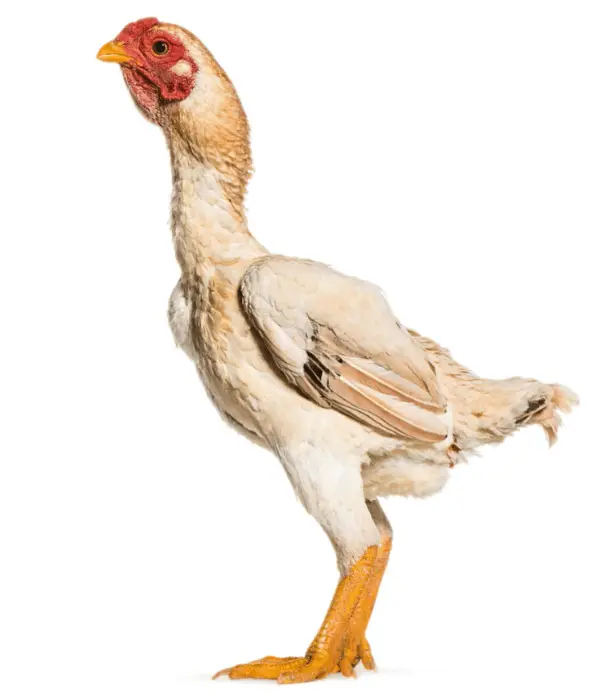
The average lifespan of a Shamo chicken is between 6 and 8 years. However, some birds are known to live for as long as 12 years.
The lifespan of a Shamo chicken depends on various factors, such as its living conditions, diet, and overall health. Providing them with proper care and nutrition ensures their well-being and longevity.
Color and Varieties of Shamo Chickens
Shamo chickens are known for their diverse color palette and distinct varieties. They come in a variety of colors which include white, black, white with brown speckled feathers, black-breasted red, and wheaten.
The American Poultry Association (APA) recognizes four color varieties of Shamo chicken: Black, Black Breasted Red, Dark, and Wheaten, including bantam and standard types.
7 Types of Shamo Chickens
There are seven recognized breeds of Shamo chicken in Japan; all designated Natural Monuments of Japan.
Shamo chickens are a type of gamefowl that originated in Japan. They are famous for their large size, upright posture, and muscular appearance.
People breed Shamo chickens for fighting but can also keep them as ornamental or show birds. There are seven main varieties of Shamo chickens, each with its characteristics and history.
1. O-Shamo
This is the most extensive and most common variety of Shamo chicken. O-Shamo means “large Shamo” in Japanese, and these birds can weigh up to 6 kg (13 lbs) for males and 4.5 kg (10 lbs) for females.
They have a broad chest, long legs, and a small head with a pea comb. Their tight and glossy feathers come in various colors, such as black, red, white, or Black Breasted Red.
2. Chu-Shamo
This medium-sized Shamo chicken is similar to the o-Shamo but slightly smaller and lighter. Chu-Shamo means “medium Shamo” in Japanese, and these birds can weigh up to 4 kg (9 lbs) for males and 3 kg (7 lbs) for females.
They have a more slender body and a longer neck than the o-Shamo, and their feathers are softer and fluffier. They also come in various colors, like black, red, white, or silver.
3. Nankin-Shamo
This is a small-sized variety of Shamo chicken that is rare and endangered. Nankin-Shamo means “southern Shamo” in Japanese, and these birds can weigh up to 2 kg (4 lbs) for males and 1.5 kg (3 lbs) for females.
Nankin Shamos have a compact body and a short neck, and their feathers are loose and silky. They have a distinctive color pattern of black and white or black and red, with a black head, neck, tail, wings, and a white or red body.
4. Ko-Shamo
This is the smallest variety of Shamo chicken, popular as a pet or a show bird. Ko-Shamo means “small Shamo” in Japanese, and these birds can weigh up to 1 kg (2 lbs) for males and 0.8 kg (1.8 lbs) for females.
They have a concise body, legs, and a large head with a walnut comb. Their tight and smooth feathers come in various colors, such as black, red, white, or silver.
5. Yakido
This rare variety of Shamo chicken is derived from the O-Shamo but has longer feathers on the neck, back, tail, and legs. Yakido means “long feathered” in Japanese, and these birds can weigh up to 5 kg (11 lbs) for males and 3.5 kg (8 lbs) for females.
They have a majestic appearance and a proud temperament and are often used as ornamental or show birds.
6. Tosa-Chibi Shamo
This is a rare variety of Shamo chicken derived from the nankin-Shamo but has shorter legs and a rounder body. Tosa-chibi means “small Tosa” in Japanese, and these birds can weigh up to 1.5 kg (3 lbs) for males and 1 kg (2 lbs) for females.
They have a cute appearance and a friendly personality and are typically kept as pets or show birds.
7. Kinpa
This is a rare Shamo chicken derived from the ko-Shamo but has curly feathers on the neck, back, tail, and legs. Kinpa means “curly feathered” in Japanese, and these birds can weigh up to 0.8 kg (1.8 lbs) for males and 0.6 kg (1.3 lbs) for females.
They have a unique appearance and lively temperament and are often used as ornamental or show birds.
Shamo chickens are fascinating birds with a long history and culture in Japan. They are admired for their strength, beauty, and personality by many enthusiasts around the world.
Shamo Chicken Breed Characteristics
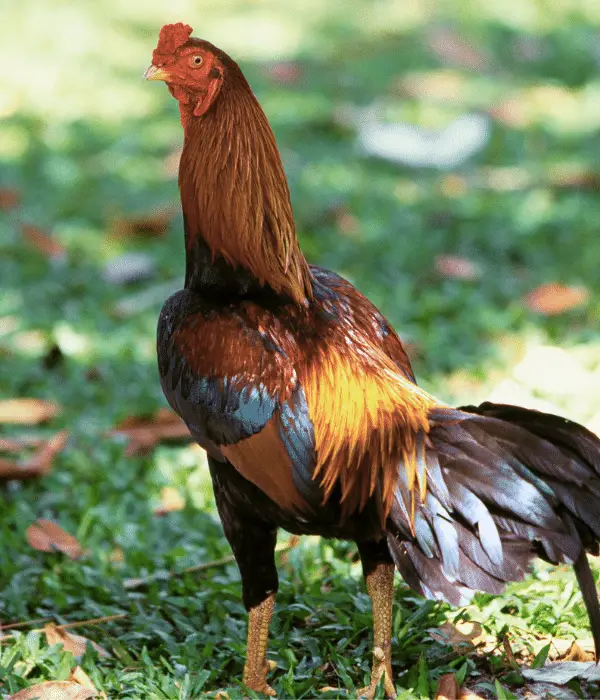
Shamo chickens have several distinctive characteristics that set them apart from other poultry breeds. These birds have a strong, muscular build, with tight, stiff feathers covering their bodies.
Their legs are long and powerful, while their necks are lengthy, giving them an impressive and commanding presence.
Shamo chickens have a unique head shape, rounded skulls, and a prominent brow. Their eyes are large and expressive, often giving them a fierce and intimidating appearance.
The comb and wattles of Shamo chickens are small and close to the head, further accentuating their unique facial features.
Shamo Chicken’s Temperament and Personality
Shamo chickens are very independent and outgoing. They like to explore their surroundings and graze on grass and insects.
Shamo chickens do not show much friendliness or affection towards humans but can tolerate handling if accustomed to it from a young age.
Shamo chickens exhibit high aggression towards other chickens, especially roosters. They possess an instinct to defend their territory and challenge rivals due to their breeding for fighting for hundreds of years.
They may fight with other breeds of chickens, so keeping them separate or providing ample space with plenty of hiding places is advisable.
Shamo chickens are hardy and adaptable. They can tolerate cold and warm climates as long as they have adequate shelter and water.
Shamo chickens are not for everyone. They require a lot of space, attention, and care to prevent them from fighting or escaping. They could be more productive and friendly as pets or farm animals.
Shamo Chickens Egg Production
Shamo chickens typically start laying eggs at around 6 to 8 months, although individual variations can occur.
Unlike some commercial egg-laying breeds, Shamo hens are not known for being prolific layers. A Shamo hen may lay around 90 to 100 eggs annually.
Shamo chicken eggs can vary in color, ranging from cream to light brown or tinted. The exact egg color can depend on individual genetics.
The Shamo hen eggs tend to be medium to large. The average weight of a Shamo egg is approximately 55 to 65 grams.
Shamo hens have a relatively low laying frequency. They may not lay eggs consistently throughout the year and can go through reduced or no egg production periods.
Some Shamo hens may also exhibit broodiness, becoming more interested in incubating eggs rather than laying them.
Shamo Chicken Size and Weight
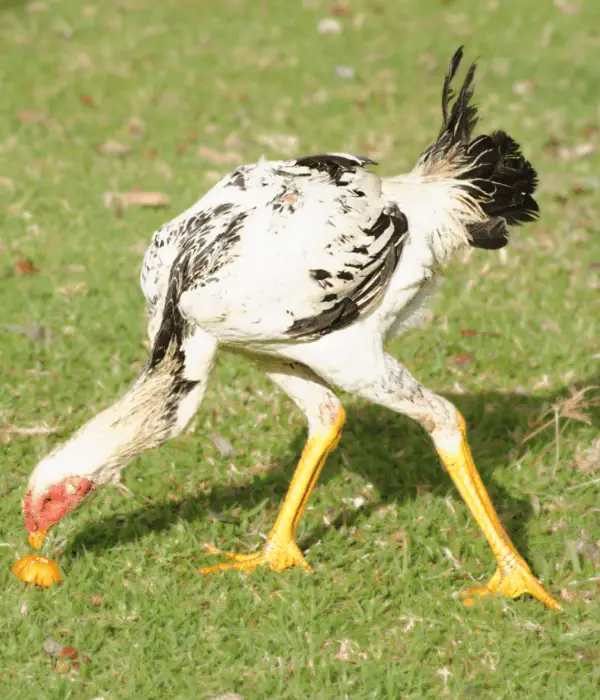
The size of Shamo chickens varies depending on the variety and the sex. There are four main varieties of Shamo: O-Shamo, Chu-Shamo, Nankin-Shamo, and Ko-Shamo. O-Shamo is the largest variety, followed by Chu-Shamo, Nankin-Shamo, and Ko-Shamo.
O-Shamo roosters weigh about 11 lbs, while O-Shamo hens weigh about 8 lbs. Chu-Shamo roosters weigh about 9 lbs, and Chu-Shamo hens weigh about 6.5 lbs.
Nankin-Shamo roosters weigh about 7 lbs, and Nankin-Shamo hens weigh about 5 lbs. Ko-Shamo roosters weigh about 4 lbs, and Ko-Shamo hens weigh about 3 lbs.
The body shape of Shamo chickens is also distinctive. They have a long neck, a broad chest, a short back, and long legs. Their tail is held high, and their wings are carried close to the body.
Shamo Chickens Appearance
The Shamo chicken stands upright and has a muscular body and fierce temperament. Its skin color ranges from black to slate gray, and is stiff and tight with little fat or subcutaneous tissue. The feathers on the face and throat are sparse, exposing the skin in these areas.
The Shamo chicken has stiff, glossy feathers that lie close to the skin. The feathers are usually short and sparse, especially on the neck, breast, and abdomen.
The feather colors vary depending on the variety of Shamo chicken, but some standard colors are black, wheaten, red, white, and silver.
The Shamo chicken has a pea comb that is small and firm. The comb is typically red or dark red. The comb has three rows of small points that are evenly spaced.
The Shamo chicken has small and round wattles that are red or dark red. The feathers on the neck often hide the wattles.
They have small and oval earlobes that are red or dark red. The feathers on the head typically hide the earlobes.
The Shamo chicken has long and strong legs that are yellow or slate gray. The legs have no feathers or scales. The toes are four in number, with one pointing backward. The toes are yellow or slate gray.
The Shamo chicken has a tall and slender body shape that resembles a V-shape when viewed from the side. The body is broad and muscular, with a prominent breastbone and a narrow abdomen.
The neck is long and curved, with a small head held high. The tail is long and fluffy, with a slight curve at the end.
Shamo Chicken Hen Vs. Rooster
The main difference between Shamo chicken hens and roosters is their size. Roosters are much larger and heavier than hens, with more prominent spurs on their legs.
Roosters also have longer and thicker feathers on their necks and tails, giving them a more majestic look. Hens have shorter and softer feathers and tend to have more color variations than roosters.
Here is a chart that shows the average size and weight of Shamo chicken hens and roosters according to their variety:
| Variety | Rooster Size (in.) | Rooster Weight (lbs) | Hen Size (in.) | Hen Weight (lbs) |
| O-Shamo | 36 | 12.4 | 30 | 7.5 |
| Chu-Shamo | 28 | 8 | 24 | 6 |
| Ko-Shamo | 22 | 4 | 18 | 3 |
Shamo Chickens Care and Management
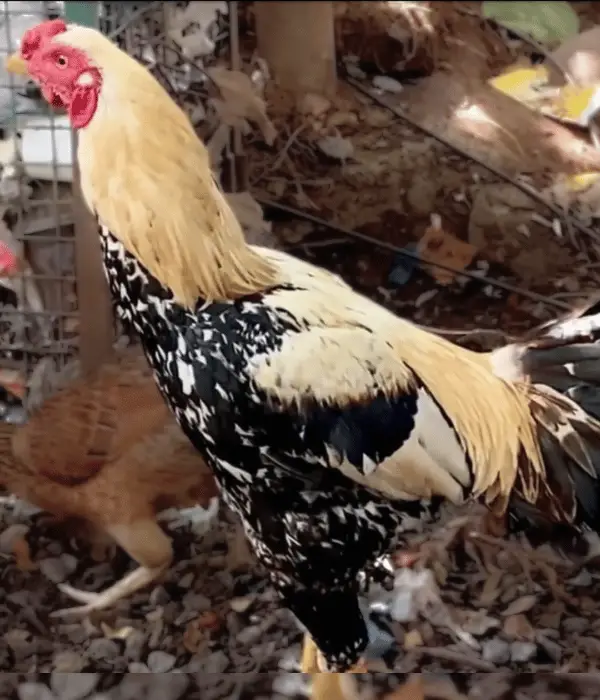
Caring for and managing Shamo chickens requires attention to their specific characteristics and needs.
Here are some essential points to consider regarding Shamo chicken care and management:
Housing
Provide spacious and well-ventilated housing to accommodate their large size and promote good airflow.
Ensure the coop is secure and protected from predators, as Shamo chickens can be more vulnerable due to their size and potential aggression. Consider providing separate housing for roosters to minimize territorial conflicts.
Exercise and Space
Shamo chickens are active birds that require ample space to move around and exercise. Allow them access to a large outdoor area or run where they can forage and explore.
Provide enough perches and structures in the coop for them to roost and jump on, as they have strong leg muscles and enjoy perching at higher positions.
Feeding
Offer them a balanced diet consisting of high-quality poultry feed appropriate for their age and stage of development.
Supplement their diet with fresh fruits, vegetables, and occasional treats like mealworms and greens. Ensure access to clean, fresh water at all times.
Health Care
Conduct regular health checks to monitor for signs of illness, parasites, or injuries. Keep their living environment clean and dry to prevent the buildup of bacteria and parasites.
Consult a veterinarian familiar with poultry if any health concerns arise.
Social Interaction
Shamo chickens can be more territorial and aggressive than other breeds, especially roosters.
Monitor their behavior closely, particularly during introductions or when keeping multiple roosters.
Provide opportunities for socialization, but be prepared to separate birds if aggression becomes excessive.
Breeding and Reproduction
If breeding Shamo chickens, ensure proper selection of breeding pairs based on desired traits and standards.
Provide appropriate nesting boxes and a secluded area for hens to lay eggs. Incubate eggs or allow hens to brood naturally, depending on the breeding goals and preferences.
Training and Handling
Start handling and socializing Shamo chickens from a young age to acclimate them to human contact.
Use positive reinforcement techniques when training, as they can be sensitive to harsh handling or punishment. Be cautious when handling adult Shamo roosters due to their potential aggression.
Understanding Aggression
Shamo chickens have a history of being used for cockfighting and may exhibit heightened territorial or aggressive tendencies.
Understand their instincts and behaviors, and take appropriate measures to manage aggression within the flock.
Nutrition and Feeding Requirements for Shamo Chickens
Feeding Shamo chickens properly is crucial for their overall health, growth, and performance.
Here are some essential points to consider regarding nutrition and feeding requirements for Shamo chickens:
High-Quality Poultry Feed
Provide a balanced and nutritionally complete poultry feed explicitly formulated for chickens.
Choose a feed suitable for their age and stage of development (starter, grower, layer, or maintenance).
Look for feeds that contain adequate protein, vitamins, minerals, and essential nutrients.
Protein Requirements:
Shamo chickens have a relatively high-protein requirement, especially during their growth phase.
Provide feed with a protein content of around 18-20% for chicks and young birds. Decrease the protein content slightly to around 15-16% for adult Shamo chickens.
Supplemental Foods
Offer fresh fruits and vegetables to supplement their diet and provide additional nutrients.
Leafy greens like lettuce, spinach, or kale are good choices.
Introduce treats like mealworms, earthworms, or scrambled eggs occasionally as protein-rich snacks.
Grit and Calcium
Shamo chickens, like all chickens, require grit to aid digestion. Provide insoluble grit, such as small stones or crushed oyster shells, to help them break down food in their gizzards.
Calcium is crucial for eggshell formation in laying hens. Offer a separate source of calcium, such as oyster shells or crushed eggshells.
Hydration
Clean, fresh water should always be available to Shamo chickens. Ensure water containers are regularly cleaned and refilled.
Use waterers to keep the water regular or prevent freezing in extreme temperatures.
Feeding Frequency and Quantity
Shamo chickens have a good appetite and may require more significant feed portions than smaller breeds.
Offer feed in appropriate amounts, ensuring they have enough to eat without excessive waste.
Provide feed at least twice a day, adjusting quantities based on their consumption and body condition.
Avoid Overfeeding
While Shamo chickens may have a robust appetite, avoid overfeeding them to prevent obesity and associated health issues.
Monitor their body condition regularly to ensure they maintain a healthy weight.
Health Supplements
Additional health supplements such as vitamins and probiotics may be beneficial depending on specific needs and circumstances.
Consult a poultry nutrition specialist or veterinarian for supplement usage and dosage guidance.
Shamo Chickens Health Issues
Shamo chickens, like all poultry, may encounter various health issues. The most common issues are related to egg-laying, with health problems such as egg-binding often occurring among hens.
The breed is also susceptible to cuts or peck marks, leading to bacterial infections if left untreated. Foot injuries are another common issue due to their active lifestyle.
Parasitic infestations, particularly mites, are another concern for Shamo chicken owners. These mites can cause discomfort and health complications if not managed effectively.
Respiratory diseases are other common ailments that can affect Shamo chickens, necessitating vigilance from the owner.
Despite these potential issues, the Shamo chicken breed does not have any specific health issues associated with it.
Regular check-ups and good poultry management practices are the best ways to ensure the health of your Shamo chickens.
Breeding and Hatching Shamo Chickens Eggs
Some characteristics of the Shamo Chicken breed make their breeding and hatching unique. Shamo hens lay around 90 light-brown eggs per year, which is lower than the egg production of many regular chicken breeds.
Despite their lower output, Shamo hens show maternal solid instincts and make excellent mothers. They often get broody and show a strong intent to hatch their eggs.
However, it is essential to note that Shamo hens can sometimes be clumsy around hatching or freshly hatched chicks due to their large size and strength. There have been instances where they accidentally break the eggs during hatching.
Due to this, if you intend to breed Shamo chickens, consider using an incubator to ensure the safe hatching of the eggs. This approach would help to protect the eggs from being accidentally broken by the hens.
Remember that the Shamo is a rare breed, so any successful breeding and hatching contribute to the conservation and continuation of this unique chicken breed.
Shamo Chickens Behavior and Their Use in Chicken Fights
While cockfighting is illegal in many countries, Shamo chickens were initially bred for this purpose.
As a result, these birds can be more aggressive and territorial than other breeds, making them unsuitable for some types of poultry keeping.
However, when raised in a nurturing environment and provided with ample space and socialization, Shamo chickens can be pretty friendly and pleasant.
They are brilliant birds and can make excellent pets for poultry enthusiasts who appreciate their unique appearance and personality.
Shamo Chicken Price
The price of Shamo chickens can vary depending on quality, age, lineage, and location.
Adult Shamo roosters and hens can range from $50 to $300 or more, with show-quality or rare color varieties potentially commanding higher prices.
Baby Shamo chicks typically range from $10 to $50 per chick, with pricing influenced by age, quality, and rarity of color variations.
It’s essential to check with local breeders or hatcheries for the current prices in your area, as they may vary based on market demand and availability.
Summary
Shamo chickens are a unique and fascinating poultry breed with a rich history and impressive appearance.
They are unsuitable for beginners or small-scale backyard farming, as they require a lot of space, care, and attention.
Mainly people raise them for ornamental purposes or cockfighting, which is illegal in many countries. Shamo chickens are also not very productive regarding eggs or meat and can be hostile to other birds and humans.
However, these chickens can be rewarding and loyal companions for those interested in this breed and with the experience and resources to keep them.
Shamo chickens’ sturdy personalities and distinctive appearance make them stand out from other breeds.
